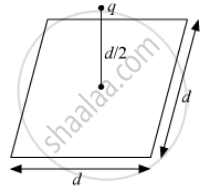Advertisements
Advertisements
प्रश्न
Find the work done in bringing a charge q from perpendicular distance r1 to r2 (r2 > r1)
उत्तर

Let's suppose the charge is moved by an infinitely small distance dr. Small work is done in moving the charge, dw = qdV where V is the Potential difference between the two points.
Now, `dV = intE.dr = -int_(r1)^(r2) (lambdadr)/(2pirepsilon_0) = lambda/(2piepsilon_0) int_(r1)^(r2) (dr)/r = lambda/(2piepsilon_0) In [r_1/r_2]`
Work done = `qdv = (qlambda)/(2piepsilon_0) In [r_1/r_2]`
APPEARS IN
संबंधित प्रश्न
"For any charge configuration, equipotential surface through a point is normal to the electric field." Justify.
Obtain the formula for the electric field due to a long thin wire of uniform linear charge density λ without using Gauss’s law. [Hint: Use Coulomb’s law directly and evaluate the necessary integral.]
A point charge q is at a distance of d/2 directly above the centre of a square of side d, as shown the figure. Use Gauss' law to obtain the expression for the electric flux through the square.

Use Gauss' law to derive the expression for the electric field `(vecE)` due to a straight uniformly charged infinite line of charge density λ C/m.
If the ratio of radii of two wires of same material is 3 : 1 and ratio of their lengths is 5 : 1, then the ratio of the normal forces that will produce the same extension in the length of two wires is:
What is the nature of the Gaussian surface involved in the Gauss law of electrostatics?
Sketch the electric field lines for a uniformly charged hollow cylinder shown in figure.

Consider a sphere of radius R with charge density distributed as
ρ(r) = kr for r ≤ R
= 0 for r > R
- Find the electric field at all points r.
- Suppose the total charge on the sphere is 2e where e is the electron charge. Where can two protons be embedded such that the force on each of them is zero. Assume that the introduction of the proton does not alter the negative charge distribution.
A solid metal sphere of radius R having charge q is enclosed inside the concentric spherical shell of inner radius a and outer radius b as shown in the figure. The approximate variation of the electric field `vecE` as a function of distance r from centre O is given by ______.

An infinitely long positively charged straight wire has a linear charge density λ. An electron is revolving in a circle with a constant speed v such that the wire passes through the centre, and is perpendicular to the plane, of the circle. Find the kinetic energy of the electron in terms of the magnitudes of its charge and linear charge density λ on the wire.
